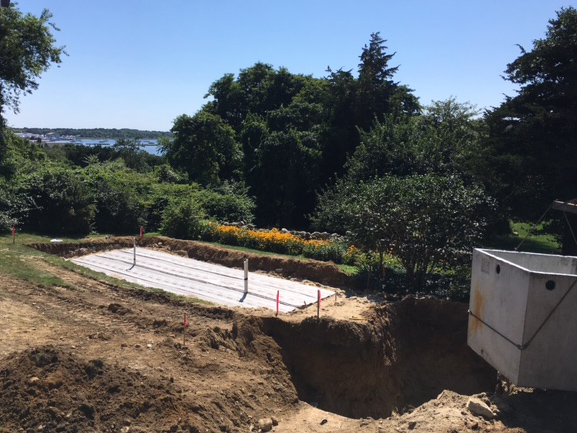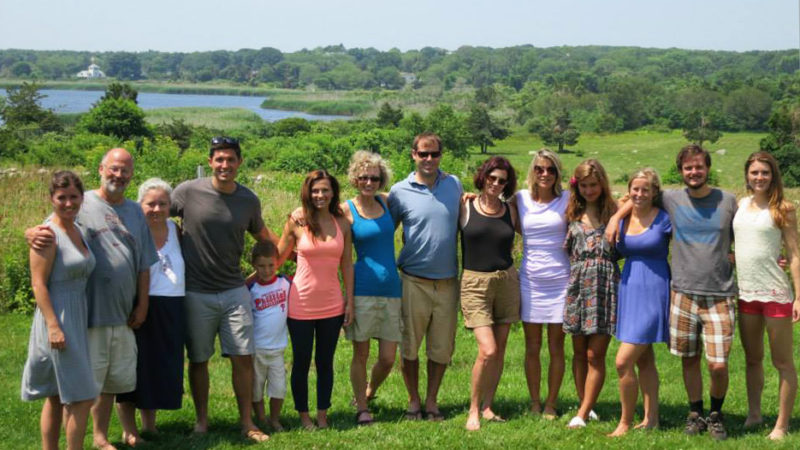New nitrogen-reducing septic systems help protect clean water in Westport
When Selden Prentice and her husband wandered into the Horseneck Point Life-Saving Station over the summer, she was looking to learn more about a growing environmental issue in her Westport neighborhood. Prentice and her family had spent their summers in Westport since the early 1990s, but recently, the Washington state-based retired lawyer had learned that nitrogen pollution was worsening water quality in the nearby Westport River.
To her surprise, when Prentice brought up the issue with a Coalition staff member, they had a suggestion for how she might help: had she considered upgrading her septic system?
In towns across Buzzards Bay, septic systems are the largest source of nitrogen pollution to our coastal waterways. Even properly functioning Title 5 septic systems cause pollution problems. That’s because they aren’t designed to remove nitrogen from wastewater. Over time, water containing high amounts of nitrogen seeps through the ground below septic systems. Eventually, it reaches the groundwater, which transports this water-clouding pollution to nearby rivers, streams, harbors, and out to Buzzards Bay.

A layer cake system being installed in Westport.
Since 2015, the Coalition has helped homeowners around the Bay reduce the impact of their home septic systems, by coordinating programs that subsidize upgrades to systems that reduce the amount of nitrogen in wastewater. This program has already led to 26 systems installed around West Falmouth Harbor, and 16 more in other towns around the Bay.
Following the merger with the Westport Fishermen’s Association in 2018 and the Coalition’s growing presence in the Westport community, there’s now a new push to bring even more nitrogen-reducing technologies to the region. These systems will address the steadily growing problem of nitrogen pollution in the Westport River, one of the most significant waterways that feeds Buzzards Bay.
Westport’s year-round population is rapidly growing; it nearly quadrupled between 1930 to 2010. This means more people using septic systems. As a result, the town’s waterways are showing clear signs that too much nitrogen is reaching their ecosystems.
Massachusetts Department of Environmental Protection (DEP) surveys have found that the upper branches of both the East and West Branch are losing their eelgrass beds, which are important habitat for fish and shellfish. The West Branch has had a middling “Fair” score on the Coalition’s Bay Health Index since the mid-1990s, while the upper portions of the East Branch consistently score in the low end of “Fair” and into “Poor.”
Prentice and her two siblings had inherited their parents’ Westport home, and upgrading the septic system seemed like a perfect way to make a difference. The house is less than a mile from the mouth of the West Branch and just up the hill from Richmond Pond, a beautiful coastal salt pond recently preserved by the Westport Land Conservation Trust in a campaign that Prentice had supported. What’s more, their parents had been closely involved in local environmental issues.

Prentice and her family in front of Richmond Pond at their Westport home.
Reducing how much nitrogen flowed to that pond and to the river felt to Prentice like “an extension of that effort,” she says, adding: “We can do our part in the way that our parents would want.”
Their family home will be one of five systems being installed in Westport this year, and one of 12 the Coalition is installing through a grant from the Environmental Protection Agency’s Southeast New England Program (SNEP). In partnership with the Barnstable County Dept of Health & Environment, the University of Rhode Island, and the consulting firm Haven & Sawyer, this grant is funding subsidies to test “layer cake” septic systems. In these systems, wastewater in a leach field passes through three levels of different material, each of which plays a different role in removing nitrogen.
So far, the other layer cake systems that the Coalition helped install — and continues to monitor around the Bay — are performing exceptionally well, removing between 70 and 80 percent of all nitrogen from treated wastewater.
In the coming year, the Coalition’s efforts to bring more nitrogen-reducing systems to Westport may be helped along by local regulations. The Westport Board of Health is considering new rules that will require that newly-constructed homes install denitrifying systems.
With construction planned to start later this fall, Prentice and her siblings are looking forward to returning to Westport next summer. She can already picture it completed, ready for another season spent on Westport’s stunning shorelines. In turn, Prentice has high hopes for her community. “My hope is that this works so well that this will be happening all over the region,” she says.
That hope is one that the Coalition shares: that these new technologies will be installed throughout the Buzzards Bay watershed, providing a cost-effective and sustainable alternative that will replace conventional, polluting systems.